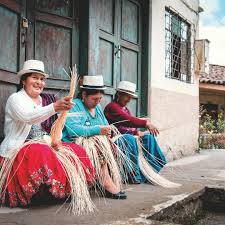Are you a bird enthusiast eager to explore new horizons? Welcome to Ecuador’s hidden gem for birdwatching, Cuenca! Nestled in the heart of the Andes, Cuenca offers a unique blend of stunning landscapes and diverse avian species, making it a must-visit destination for nature lovers.
Imagine starting your day with the melodious songs of rare Andean birds, surrounded by lush greenery and breathtaking views. Cuenca’s birdwatching spots are not only a haven for bird species but also provide a serene escape from the hustle and bustle of city life. Whether you’re an avid birder or a curious traveler, the birdwatching opportunities in Cuenca promise an unforgettable experience.
In this blog post, we’ll take you on a journey through the top birdwatching spots in Cuenca, revealing the best locations to spot rare and exotic birds. From the high-altitude ecosystems of Cajas National Park to the vibrant wetlands of Yunguilla Reserve, Cuenca’s birdwatching spots cater to all levels of birding expertise. Along the way, we’ll share tips on the best times to visit, what to bring, and how to make the most of your birdwatching adventure.
Join us as we delve into the rich avian diversity of Cuenca, uncovering the secrets of its feathered inhabitants. Get ready to be amazed by the beauty and variety of birds that call this enchanting city home. Let’s embark on this exciting journey together!
Exploring El Cajas National Park
Just a short 45-minute drive from Cuenca, El Cajas National Park is a paradise for birdwatchers. This expansive park is home to over 230 lakes and a variety of ecosystems, including Andean mountain forests and paramo grasslands. Such diversity makes it one of the prime birdwatching spots in Cuenca.
Bird enthusiasts can expect to see a range of rare and exotic species in their natural habitats. Among the most sought-after birds are the Violet-throated Metaltail and the Andean Guan. These species, along with many others, make El Cajas a must-visit for anyone interested in avian life.
Unique Bird Species in El Cajas
El Cajas National Park is renowned for its unique bird species. Here are some of the notable birds you might encounter:
- Violet-throated Metaltail: This endemic hummingbird is a highlight for many visitors.
- Andean Guan: Often spotted in the park’s forested areas.
- Gray-breasted Mountain Toucan: A colorful and striking bird that is a favorite among birdwatchers.
- Tawny Antpitta: Known for its distinctive call and elusive nature.
- Blue-mantled Thornbill: Another beautiful hummingbird species found in the park.
Guided Tours and Best Times to Visit
To make the most of your birdwatching experience, consider joining a guided tour. Many local companies offer tours led by experienced birdwatchers who can help you spot and identify various species. These tours often include transportation, binoculars, and a bird list of the area.
The best times to visit El Cajas for birdwatching are during the early morning or late afternoon when birds are most active. The park is open year-round, but the dry season (June to September) typically offers better weather conditions for birdwatching.
Exploring the Park’s Ecosystems
El Cajas National Park boasts a range of ecosystems, each offering unique birdwatching opportunities. The Andean mountain forests are home to species like the Spectacled Whitestart and the Tyrian Metaltail. In the paramo grasslands, you might spot the Stout-billed Cinclodes and the Tit-like Dacnis.
Additionally, the park’s numerous lakes attract various waterfowl and shorebirds. Keep an eye out for the Andean Teal and the Yellow-billed Pintail as you explore these aquatic habitats.
For more information on birdwatching tours and other activities in Cuenca, visit our website. Happy birdwatching!
Discovering Yunguilla Jocotoco Reserve
Located southwest of Cuenca, the Yunguilla Jocotoco Reserve is a hidden gem for birdwatchers. This reserve is renowned for its rare bird species and diverse habitats, making it a prime location for birdwatching enthusiasts. One of the most notable species found here is the Pale-headed Brush-Finch, a bird that has captivated ornithologists and bird lovers alike.
The reserve’s unique combination of forests, scrublands, and open areas creates an ideal environment for a wide variety of bird species. Whether you’re an experienced birder or a novice, Yunguilla Jocotoco Reserve offers an unforgettable birdwatching experience.
Unique Bird Species in Yunguilla Jocotoco Reserve
Yunguilla Jocotoco Reserve is home to several rare and endemic bird species. Here are some of the notable birds you might encounter:
- Pale-headed Brush-Finch: This critically endangered bird is the star attraction of the reserve.
- Chestnut-crowned Antpitta: Known for its distinctive call and elusive nature.
- Rainbow Starfrontlet: A vibrant hummingbird that adds a splash of color to the reserve.
- Slate-throated Redstart: Often seen flitting through the forest undergrowth.
- Golden-olive Woodpecker: A striking bird that is a favorite among visitors.
Guided Tours and Best Times to Visit
To enhance your birdwatching experience, consider joining a guided tour. Many local companies offer tours led by experienced birdwatchers who can help you spot and identify various species. These tours often include transportation, binoculars, and a bird list of the area.
The best times to visit Yunguilla Jocotoco Reserve for birdwatching are during the early morning or late afternoon when birds are most active. The reserve is open year-round, but the dry season (June to September) typically offers better weather conditions for birdwatching.
Exploring the Reserve’s Habitats
The diverse habitats within Yunguilla Jocotoco Reserve provide unique birdwatching opportunities. The forested areas are home to species like the Purple-throated Sunangel and the Hooded Siskin. In the scrublands, you might spot the Band-tailed Pigeon and the Peruvian Pygmy Owl.
Additionally, the open areas of the reserve attract various raptors and other birds of prey. Keep an eye out for the Black-chested Buzzard-Eagle and the Crimson-mantled Woodpecker as you explore these habitats.
For more information on birdwatching tours and other activities in Cuenca, visit our website. Happy birdwatching!
Birdwatching Along the Gualaceo-Limón Road
The Gualaceo-Limón Road offers a unique birdwatching experience, connecting the Azuay and Morona Santiago provinces. This scenic route traverses various ecosystems, providing opportunities to spot a wide range of bird species. Whether you’re an experienced birder or a novice, this road promises an unforgettable adventure.
Stretching for roughly 77 kilometers, the Gualaceo-Limón Road allows birdwatchers to explore elevations ranging from 3,360 meters to 1,900 meters. This elevation gradient supports diverse habitats, each home to unique avian species. Let’s delve into the different ecosystems and the birds you can expect to see along this route.
Exploring Diverse Ecosystems
As you travel along the Gualaceo-Limón Road, you’ll encounter several distinct ecosystems:
- Páramo Grassland: At the highest elevations, this ecosystem is characterized by its open, grassy landscapes. Here, you might spot the Páramo Tapaculo and the Mouse-Colored Thistletail.
- Elfin Forest: Moving down the slope, the elfin forest is a dense, stunted woodland. Keep an eye out for the elusive Rainbow-Bearded Thornbill and the Viridian Metaltail.
- Temperate Forest: This lush, green forest is home to species like the Masked Mountain-Tanager and the Black-Backed Bush-Tanager.
- Upper Montane Forest: In this ecosystem, you can find birds such as the Mountain Wren and the Blue-Necked Tanager.
- Middle Montane Forest: At lower elevations, this forest supports a variety of birds, including the Grass-Green Tanager and the Masked Flowerpiercer.
Guided Tours and Best Times to Visit
To enhance your birdwatching experience, consider joining a guided tour. Many local companies offer tours led by experienced birdwatchers who can help you spot and identify various species. These tours often include transportation, binoculars, and a bird list of the area.
The best times to visit the Gualaceo-Limón Road for birdwatching are during the early morning or late afternoon when birds are most active. The road is accessible year-round, but the dry season (June to September) typically offers better weather conditions for birdwatching.
For more information on birdwatching tours and other activities in Cuenca, visit our website. Happy birdwatching!
Embrace the Beauty of Birdwatching in Cuenca
Birdwatching in Cuenca offers a unique opportunity to connect with nature and observe rare bird species in their natural habitats. Whether you explore El Cajas National Park, Yunguilla Jocotoco Reserve, or the Gualaceo-Limón Road, you’re sure to have an unforgettable experience.
Cuenca’s diverse ecosystems, from high-altitude paramo grasslands to lush temperate forests, attract an array of avian species that will captivate both novice and experienced birdwatchers. Highlights include the endemic Violet-throated Metaltail in El Cajas and the critically endangered Pale-headed Brush-Finch in Yunguilla. Each location offers its unique charm and birdwatching opportunities, making Cuenca a must-visit destination for bird enthusiasts.
- El Cajas National Park: Home to over 230 lakes and a variety of ecosystems, offering sightings of the Violet-throated Metaltail, Andean Guan, and Gray-breasted Mountain Toucan.
- Yunguilla Jocotoco Reserve: A haven for rare species like the Pale-headed Brush-Finch, Chestnut-crowned Antpitta, and Rainbow Starfrontlet.
- Gualaceo-Limón Road: This scenic route traverses diverse habitats, providing opportunities to spot the Páramo Tapaculo, Masked Mountain-Tanager, and Blue-Necked Tanager.
To fully immerse yourself in Cuenca’s birdwatching splendor, consider booking a guided tour. Local experts can enhance your experience with their knowledge and keen eye for spotting elusive species. Additionally, staying at the Hotel Boutique Mansión Alcázar will provide you with a luxurious retreat after a day of birdwatching adventures.
Ready to embark on your birdwatching journey in Cuenca? Visit our website to learn more about our accommodations and guided tours. Embrace the beauty of Cuenca’s avian wonders and create memories that will last a lifetime. Happy birdwatching!




